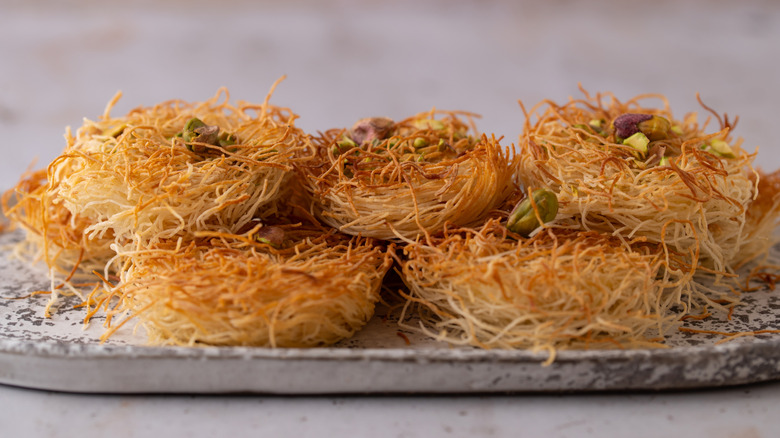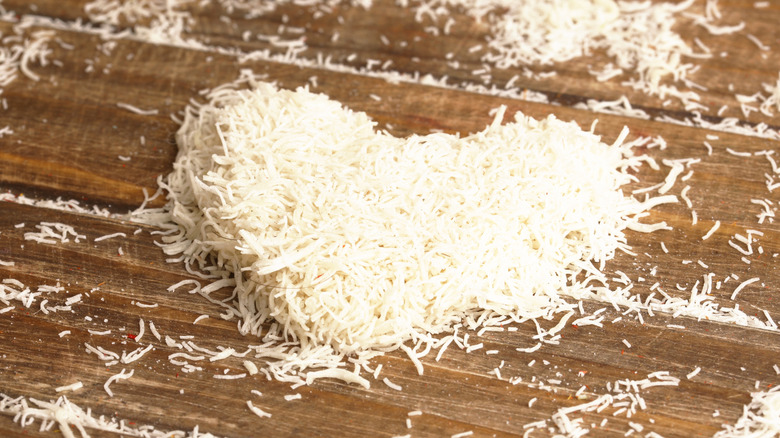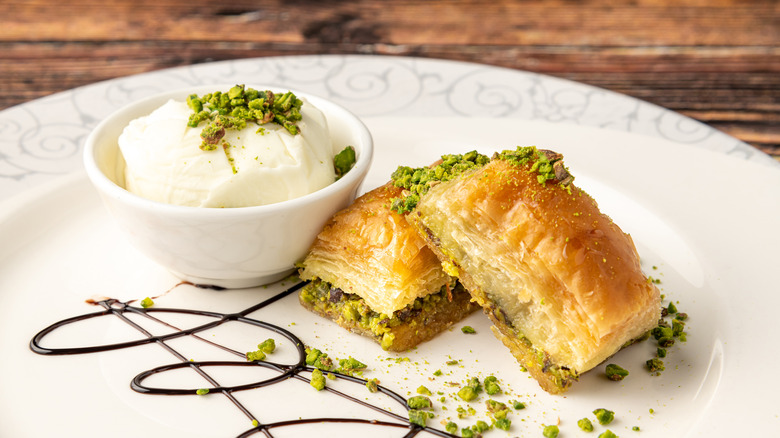What Is Kataifi And How Does It Differ From Baklava?
The world of Middle Eastern desserts is wide, varied, and oh-so-delicious. Honey cakes, tahini-based halva, date bars, and dense, crumbly, citrusy-sugary basbousa are all vital pieces of this culinary tapestry. Some dishes, like katmer, offer the added appeal of being served for breakfast. And, of course, there's baklava, the cousin of katmer and the supreme deity of the Mediterranean dessert pantheon.
Recently, a new dessert item has entered the American public's awareness, thanks in part to a viral Dubai chocolate bar that has taken the internet by storm. The ingredient is called kataifi, and like baklava, it's often served with chopped walnuts or pistachios and soaked in a light, delicious syrup. In fact, the Greeks have a name for this category of desserts: syropiasta, which means bathed in syrup.
While kataifi and baklava are related, there are several differences that define the two dishes. What will stand out most to first-time tasters of kataifi is the texture, which is often compared to vermicelli noodles or shredded wheat. The name means "tousled" or "tangled" in Greek, and one look at the thin strands layered or interwoven on top of themselves makes it clear why. While baklava is made from sheets of phyllo dough, kataifi is made of spun strands of dough made from a batter.
Kataifi is a thin dough with wide application
While kataifi might be a relatively new term to American eaters, it's incredibly popular throughout Greece, Turkey, and other countries in the Middle East. Crunchy and sweet, the strands of dough might seem complicated to make and work with, but it's surprisingly easy.
To make kataifi, all you need are flour, water, cornstarch, oil, and salt. Combine the ingredients into a batter, strain it to remove lumps, and pour it into a squeeze bottle. Then, simply squeeze thin lines of the batter onto a hot pan over medium heat, creating a spiral of batter. After a few seconds, the batter will harden into a long, still-pliable strand, which can be cut into smaller segments and made ready for baking.
There are many delicious uses for kataifi. Ekmek kataifi is a layered dessert popular in Greece and Turkey made by topping syrup-soaked kataifi with custard and whipped cream with pistachios sprinkled on top and served cold. It's also a key ingredient in knafeh, a Palestinian dish in the limelight thanks to its inclusion in the Dubai chocolate bar. This dessert, also called kunafa, uses kataifi to house a delicious milk pudding, which is then covered in light syrup. In recent years, its usage has even been adapted to mimic Vietnamese vermicelli noodles, such as wrapping shrimp in the dough and baking it to make a crunchy, savory dish.
Baklava is an ancient dessert that has undergone many variations
Baklava's history is long and contested, but it's clear that variations of the dessert have been around for centuries. Versions of the dish can be traced all the way back to the Assyrian empire in the 8th century B.C., when flatbreads were layered with chopped nuts as a celebratory treat. In the Ottoman age, it was considered a nearly sacred part of Ramadan, and over the years, it spread to Christian celebrations of Lent and Jewish Rosh Hashanah festivities. In modern baklava, the dough is thinned out to the maximum degree, a process that requires intense care and training, and then stacked in 10 layers, thereby achieving its distinctive texture.
Two of the most common forms of baklava we know today are the Bosnian and Turkish varieties, which differ both in terms of nuts and the type of syrup used. Bosnian baklava tends to use walnuts and a syrup made from sugar, water, and lemon, while Turkish baklava primarily uses pistachios and uses either a similar syrup to the Bosnian version or one that includes honey, making it thicker.
Despite the differences between the preparation process of baklava and kataifi, they find a common ground in the dessert osh el bulbul, or nightingale's nest — but also known, fittingly, as "bird's nest baklava." Here, kataifi is wrapped around the cook's fingers in a tight ball, thereby forming the titular nest, and is topped with pistachios and brushed with butter before being baked and then covered in delicious syrup.



